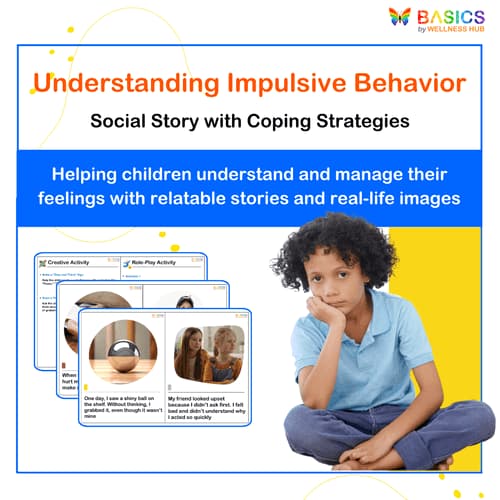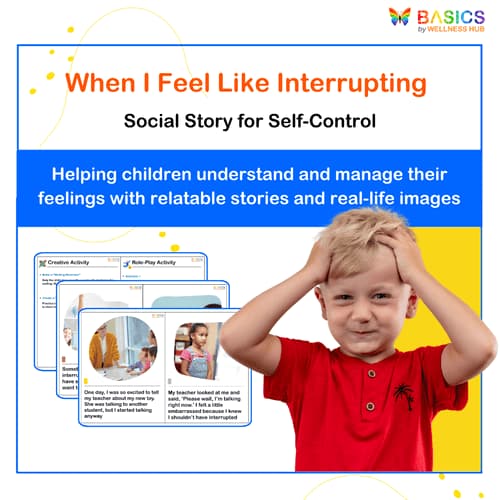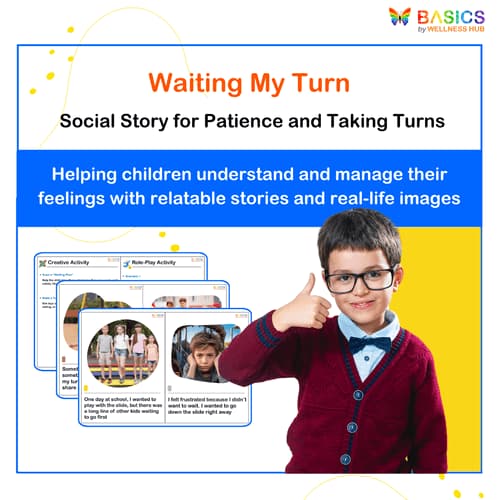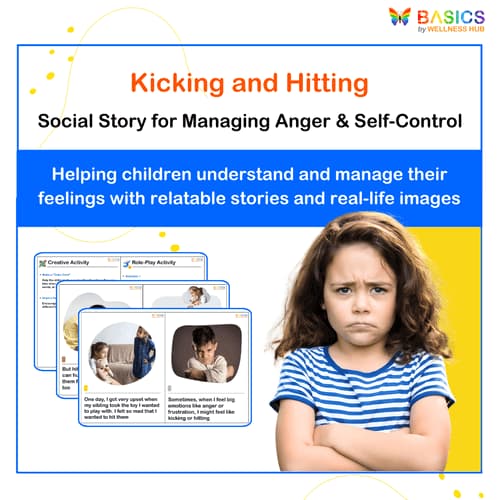





I’m Sad - A Social Story for Kids Helping children understand and cope with feelings of sadness.
₹80
₹160
50% off
0 (0 ratings)
Grade Levels
Pre-K - Grade 2 (Ages 3-7)
Content Overview
1 PDF with 6 pages, featuring realistic images and relatable first-person narrative. Features: Simple language, continuous story, high-quality real-life images.
Pages from the Resource
The I’m Sad social story helps children understand and manage their feelings of sadness. Through a relatable narrative and real-life images, this resource guides children on how to express and cope with their emotions in a healthy way.

Page 1

Page 2
What Users Say
0
0 ratings
5
0+
4
0+
3
0+
2
0+
1
0+
5 Stars
Product is Good to use.
10 months ago
Varsha Parent
Similar Products

Understanding Impulsive Behavior: Social Story with Coping Strategies
₹ 80.00
₹ 160.00
50% off
4.9 (42 ratings)

When I Feel Like Interrupting – Social Story for Self-Control
₹ 80.00
₹ 160.00
50% off
4.8 (60 ratings)

Waiting My Turn – Social Story for Patience and Taking Turns
₹ 80.00
₹ 160.00
50% off
4.7 (56 ratings)

Kicking and Hitting – Social Story for Managing Anger & Self-Control
₹ 80.00
₹ 160.00
50% off
4.6 (52 ratings)

Understanding Swear Words – Social Story for Respectful Communication
₹ 80.00
₹ 160.00
50% off
4.9 (48 ratings)
About the Product
Purpose of Flashcards: The I’m Sad - A Social Story for Kids is designed to help children understand and navigate the feeling of sadness. This resource is presented in a first-person narrative, making it relatable for young learners who might be struggling with identifying or expressing their emotions. By using real images and creating a cohesive storyline, children can see themselves in the situations described, providing them with comfort and strategies for managing their emotions. The resource is particularly beneficial for children with special needs, including those with autism or learning difficulties, as well as any child who needs support in social-emotional development.
Product Details
Format: 1 PDF
Total Number of Pages: 6
Content Overview:: The PDF contains 6 pages, each with 2 statements accompanied by high-quality real images that visually represent each scenario. The story uses a continuous narrative, making it feel like a seamless journey for the child reading it.
Features: First-person narrative, realistic images, and simple language for easy understanding.
Educational Benefits
Emotional Awareness and Understanding: This resource aids in helping children recognize and label the emotion of sadness, teaching them that it is a normal feeling that everyone experiences.
Self-Expression and Communication: By relating to the story, children are encouraged to express their own feelings more effectively. It provides them with language they can use to articulate what they feel.
Problem-Solving and Coping Strategies: The social story offers simple, child-friendly strategies for coping with sadness, such as deep breathing, talking to a trusted adult, or engaging in comforting activities like hugging a favorite toy.
Empathy and Perspective-Taking: Children learn to empathize with others who might be feeling sad by understanding that everyone has different experiences that make them feel this way.
Visual Learning Support: The use of realistic images aids visual learners in connecting the written content with real-life scenarios, making the message more memorable and impactful.
Instructions for Use
Introduction and Familiarization: Start by introducing the concept of sadness to the child. Explain that it’s normal to feel sad sometimes, and that this story will help them learn more about how to manage those feelings.
Reading Together: For younger children, read the story aloud while showing them the images. Pause at each scenario to ask questions like, “Have you ever felt this way?” or “What would you do in this situation?”
Repetition and Reinforcement: Revisit the story regularly, especially during moments when the child may be feeling sad. Repetition helps reinforce the strategies introduced in the story.
Role-Playing Activities: After reading the story, encourage the child to role-play some of the strategies, such as practicing deep breathing or expressing how they feel using the words from the story.
Discussion and Reflection: Engage the child in conversations about what makes them feel better when they’re sad. Use this as an opportunity to reinforce the coping strategies in the story.
Use in Various Settings: This resource can be used both at home and in classrooms or therapy sessions. It’s particularly helpful for social-emotional learning (SEL) activities.
Activities Using the Resource
Discussion Time: After reading the social story with the child, engage them in a discussion about times when they felt sad. Encourage them to describe what happened, how they felt, and what they did to cope. This activity helps in reinforcing the strategies provided in the story and allows the child to express their emotions openly.
Role-Playing: Use the scenarios in the story to set up simple role-playing exercises. For example, act out a situation where the child feels sad, and then practice the coping strategies mentioned, such as taking deep breaths, talking to a trusted adult, or hugging a comforting object. This helps children internalize the techniques by practicing them in a supportive setting.
Drawing and Art Activity: Provide the child with drawing materials and ask them to draw a picture of something that makes them feel better when they’re sad. This could be a favorite place, a loved one, or a comforting object. Use the drawings to further discuss the strategies mentioned in the story.
Emotion Sorting Game: Create cards with different emotions (happy, sad, excited, etc.) and ask the child to sort them based on how they feel during certain situations. This activity builds on their understanding of emotions and helps them connect their feelings with coping strategies.
Daily Reflection: At the end of each day, sit down with the child and talk about their feelings throughout the day. Ask them if there was a moment when they felt sad and how they managed it. This reflection time encourages them to use the strategies from the social story in real-life situations.
FAQs
Q1: Is this social story suitable for children with special needs?
A1: Yes, this social story is specifically designed with simple language, real images, and relatable scenarios to support children with special needs, including those with autism, developmental delays, and emotional regulation difficulties.
Q2: Can this story be used for children who are non-verbal?
A2: Absolutely. The visual aids and simple, relatable scenarios make this resource accessible for non-verbal or minimally verbal children. They can point to the images or use other forms of communication to express their understanding.
Q3: How often should I read this social story with my child?
A3: You can read the story regularly as part of a daily routine, particularly during moments when the child might be experiencing or discussing emotions. Repetition helps reinforce the strategies and language introduced.
Q4: Can this resource be used in group settings, like a classroom or therapy group?
A4: Yes, this social story is versatile and can be used in one-on-one settings, small group therapy sessions, or classrooms. The scenarios and coping strategies are universally applicable.
Q5: What if the child does not seem to relate to the specific scenarios in the story?
A5: The goal of the social story is to introduce general strategies for coping with sadness. If the scenarios don’t match the child’s specific experiences, you can adjust the discussion to focus on situations that are more relevant to them while still applying the same strategies.
Usage Rights and Restrictions
Personal Use Only: This social story is intended for personal use by the purchaser, whether at home, in a single classroom, or during therapy sessions.
No Redistribution: The resource may not be shared, distributed, or reproduced for multiple users, classrooms, or commercial purposes without additional licensing.
Digital and Print Usage: You may print copies for personal or classroom use, and you may also use the digital version on a single device for teaching or therapy purposes.
Commercial Use Prohibited: The resource is strictly for non-commercial use. Mass distribution, sharing across multiple platforms, or resale is not permitted.
Conclusion
Thank you for choosing the I’m Sad - A Social Story for Kids. We hope this resource provides valuable tools for helping children manage and understand their emotions in a supportive and relatable way. By incorporating real-life scenarios, realistic images, and effective coping strategies, this social story serves as a practical guide for navigating sadness. Whether used at home, in a classroom, or in therapy sessions, this resource is designed to empower children to express and manage their emotions with confidence and resilience.



